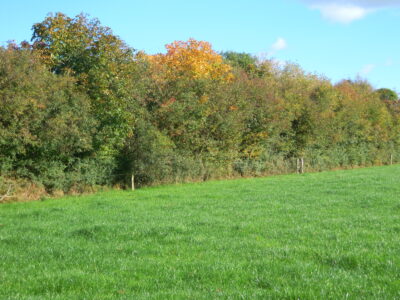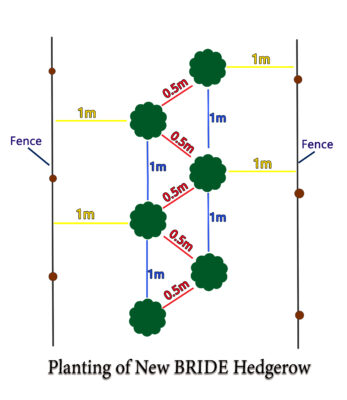Hedgerow
Overview
Hedgerows have been used to define field, farm, parish and even county boundaries and they are a very ancient and important part of our heritage.
They were also used as livestock enclosures and thus needed to be stockproof. This is why many of our hedgerows contain thorn species such as Hawthorn (Whitethorn), Blackthorn, Holly, Dog Rose, Bramble and Gorse (Furze). Hedgerows create shelter from rain and sun for livestock as well as a very important habitat for a wide range of plant and animal species.
The electric fence has now replaced these and is being used to reinforce stockproof hedging on many farms.
The BRIDE Project hedgerow mix introduces several other native and less widely used species such as Guelder Rose, Spindle, Hazel, Buckthorn, Alder Buckthorn and Bird Cherry to enhance the biodiversity value of this new approach to hedgerow creation.

Creation
New hedgerows should ideally be located alongside a farm passageway or can be used to replace an existing wire fence boundary. If planting beside a farm passageway, ensure it is set back far enough from the passageway (2m) such that it does not interfere with livestock, electric fences or machinery.
Have the ground as bare as possible before planting a new hedgerow. The plants should be spaced at 3 per metre in a staggered line using the BRIDE Project hedgerow mix (up to 15 species – use at least 8 species). The mix contains many different species as the focus is on improving biodiversity rather than making the hedgerow stockproof.

Management
Existing Hedgerows: All BRIDE Project hedgerows should be allowed to grow and mature so that their full biodiversity and carbon sequestration value can be achieved. They should be side trimmed only, to prevent encroachment and this will need to be carried out every year or at least every 2 years.
New Hedgerows: If rabbits or hares are a problem, guards will need to be used and will be an additional cost where this is an issue. Over the first and possibly second year, vegetation will need to be kept down to ensure the new plants are not out-competed. Trampling around the plants in the first year of establishment will prevent undergrowth build-up. The first year can also be problematic for the plant if drought conditions occur. The new hedgerow may need watering if this is the case. Wind rock can be an issue before the plant gets properly rooted so ensure the plant is upright and straight at all times.
Benefits
Hedgerows create shelter from rain and sun for livestock as well as a very important habitat for a wide range of plant and animal species. Hedgerows provide corridors for wildlife that enable them to connect with other habitats. A mature hedgerow will visually enhance the farm you work on and also the countryside you live in. It can also prevent run-off from farmland thus preventing flooding, soil erosion and pollution. Hedgerows also significantly lower your carbon footprint.
Further Information
Further information can be found on page 32 of our publication – “The BRIDE Project EIP Farm Habitat Management Guidelines” – link HERE
